His early work was profound. And he generated quite a lot of work that was exceptionally good. They were skillfully done. Even though they had a dreamy quality they were not lazy abstractions. They were created with great thought and care. The mediums, the textures and the subjects reflect the nature and importance of family life, community, faith and love. It is as though Chagall is holding his heart in his hand for everyone else to see. And that is a very brave thing for an artist to do.
Yes, it is all there.
Transparent
joyful, gasping for air or
letting go of everything
on such a deep level that all that matters
cannot even touch the ground.
Marc Chagall is an historical commentator. We see humanity in the context of his work and the heartache that is often expressed is so intense it cannot be denied. It is like catching air in the middle of a breath and then being paralyzed and not being able to breathe again.
After breaking away for a bit and reading his bio and then looking through his body of work; I find it interesting that now I hardly need to see a date to know when he created his paintings.
The work he did while he was in Russia with the love of his life, his wife Bella Rosenfeld was warm and inviting. Its peaceful even though these works were painted during WWI and during a time when antisemitism was severe. And yet...
Look at these painted from 1915-1920.
Window at the Dacha 1915 The Poet Reclining 1915
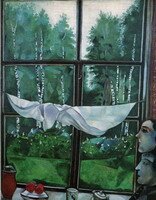
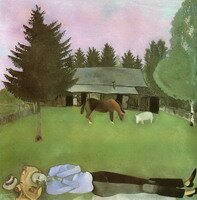
The Birthday 1915
Bella and Ida by the Window 1916
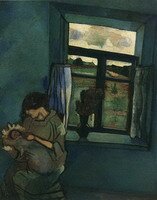
The Blue House 1917
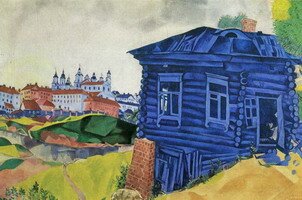
Cemetery Gates
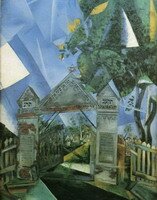 Peasant Life 1917
Peasant Life 1917The Promenade 1917-1918
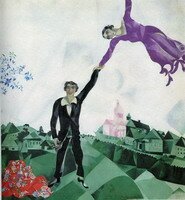
Synagogue 1917 Grey Lovers 1917
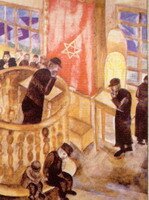
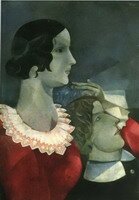
The world was at war. He had visited countries that were now at war. He was living in Russia. And yet there is a small town, out in the middle of way out there Russia and still in stead of seeing a bleak depiction of life it is rather - normal and peaceful.
Its as though his canvas and the world he was creating was a refuge to the harsh realities of that time in history. Maybe he struggled with keeping sane by focusing on the life of those in his family and his community. I don't know.
But I do know that during a dark time, for vastly different reasons, I painted three canvases, three oil canvases that year and each was a central yellow flower as the subject with a rich but very dark earthy background. It was all I could see that year. I think I painted other things. But yeah, why yellow flowers against a dark background? And I rarely paint flowers.
Yellow Dahlia, Yellow Iris Petite and Yellow Iris Grande
I tend to be drawn to artists who are reflected through their work: Whose work grows and changes like the branches of a great tree, sprawled in the midst of a grande expanse. I like being able to see each turn in their lives, the bend of every bough and the broke out hollow in the belly of its twisted torso. Because that is life. It has joy and change and sorrow and sorting things out and making sense or going insane because of a suffering that could not be reconciled. I think that is why an artist that are more formulaic doesn't interesting to me. Because while the formula may be attractive on a wall, life is complex and constantly changing. When I see life in a body of work I know that the artist is revealing something true about their life and the time in which they lived. And that has always intrigued me.
Chagall was offered a job to work for the Russian Ministry as the Chief of Fine Arts Department but he said no. He continued to study in Vitebsk until he left for Berlin for a one man show and then he and his wife and daughter left Berlin for Paris. When the Nazi's occupied Paris the Chagall's were trapped. But with some help they went to the United States in 1941 and there they stayed throughout the remainder of WWII. Bella tragically died in 1944 of a virus. And Chagall left for Paris in 1945.
I don't think during that time in our history, his life was like splattered grease hopping out of the frying pan and just barely missing the direct fire. Maybe that is what the splintered reality that grows increasingly more interesting to him, comes from.
Here we see his work is changing dramatically. Now the war is touching him, touching his family, removing his community.
Le Juif errant 1923-1925
The Peasant Life 1925
Chagall Marriage to Bella 1914

Bella with White Collar 1917
Time - The river without banks 1930-1939

Fallen Angel 1923-1947
What the world had turned into and his feelings about its uncertainty are clearly visible in his work.
A few months after the French succeeded in liberating Paris from Nazi occupation, with the help of the Allied armies, Chagall published a letter in a Paris weekly, "To the Paris Artists":
In 1945 Chagall went to go live with his daughter Ida, and her husband. He met and had a romance with Virginia Haggard, daughter of author, Henry Rider Haggard. They had a son, David McNeil in 1946 and their relationship lasted for seven years.In recent years I have felt unhappy that I couldn't be with you, my friends. My enemy forced me to take the road of exile. On that tragic road, I lost my wife, the companion of my life, the woman who was my inspiration. I want to say to my friends in France that she joins me in this greeting, she who loved France and French art so faithfully. Her last joy was the liberation of Paris... Now, when Paris is liberated, when the art of France is resurrected, the whole world too will, once and for all, be free of the satanic enemies who wanted to annihilate not just the body but also the soul—the soul, without which there is no life, no artistic creativity.[12]:101
I could find only one painting from 1945.
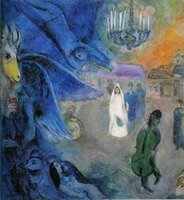
The Wedding Lights 1945
I'll be adding a little more to this post but wanted to read it and fool with it awhile and decided to post it.
Marc Chagall has a huge body of work and lived a really interesting life so there is lots to write about. I am discovering so much of his work that I haven't seen that I'm really enjoying the research.
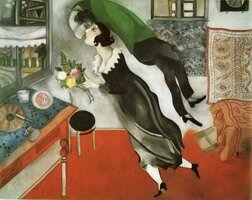
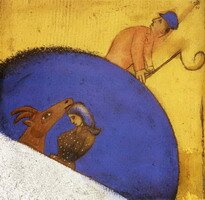






No comments:
Post a Comment